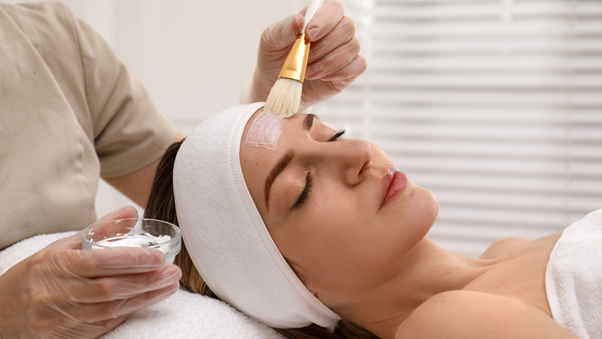We live in an era where multiple progressive treatments, both surgical and non-surgical, are available to help us look younger, fresher, and more rested. Sometimes, it feels like a new and innovative skin-rejuvenating treatment pops up each day. However, when it comes to peels, it may feel like they have been around for ages.
And you may not be far off. As a matter of fact, chemical peels have been practised for thousands of years. Naturally, the peels consisting of natural remedies used in Ancient Egypt are not the same as the highly specialised dermatological peels on offer to us today. But one thing remains, they have stood the test of time and are STILL loved to this present day.
If we look at some of the stats. A report by ISAPS estimates that over 15 million chemical peel procedures were performed worldwide in 2021. In the US alone, the American Society of Plastic Surgeons reported more than 1.4 million chemical peels in 2023, placing it among the top five minimally invasive cosmetic treatments. Meanwhile, the UK accounted for roughly 5.5% of the global chemical peel market revenue in 2022, and stands out as the fastest-growing market in Europe.
But what exactly is a chemical peel? And is it one-size-fits-all? Let’s break it down.
So, How Do Chemical Peels Work?
It is all in the name. A chemical peel is a non-surgical treatment where a special chemical solution is applied to the top layer of your skin. This solution is designed to then gently remove the dull, dry, and damaged layer (or layers). As your old skin sheds, new skin grows in its place, which is, of course, usually smoother, has fewer wrinkles, and a more even tone and texture. Plus, peels are not just for your face, they can be used on your neck, back, and even your hands. Whether you are planning on booking your chemical peel in London or New York, typically there are three main types of chemical peels, each varying in strength and purpose, on offer.
- Superficial Peels
These use mild acids like alpha hydroxy acids (AHAs) to gently exfoliate. They only penetrate the outermost layer of skin (epidermis) and are great for brightening skin and improving texture. Here are the numbers. Superficial peels, like those with glycolic acid, salicylic acid, or lactic acid, can improve mild signs of sun damage by about up to 80% after a series of treatments. For mild acne, they can reduce pimples by around 40 to 60% after a few sessions. And, most people (up to 90%) are happy with how their skin texture and tone look after using these peels and give superficial peels the thumbs up. - Medium Peels
Using trichloroacetic acid (TCA) or glycolic acid, medium peels reach the middle layers of the skin. They are highly effective for treating pigmentation issues, age spots, and fine lines, and boast equally satisfying stats as seen above. For example, studies indicate that medium peels can improve fine lines and moderate wrinkles by 60 to 80%, with results lasting up to a year or more when properly maintained. And, these treatments also flaunt a high satisfaction rate, ranging from 75 to 90%. - Deep Peels
The most intense out of the three are deep peels. These peels often use phenol to penetrate deep into the dermis and are typically used to combat severe wrinkles, scars, and precancerous growths and require significant downtime (sometimes up to 4 weeks). However, if you are struggling to wave goodbye to deep lines and wrinkles, you may be happy to know that studies show a remarkable 70 to 90% improvement in both deep wrinkles and fine lines after just one session of a deep peel, such as a phenol peel.
Celebrities Who Swear By Chemical Peels
Ageing comes for us all, and therefore it should come as zero surprise that these peels have become a red carpet staple too. Hollywood elites like Jennifer Aniston have praised glycolic acid peels for keeping her skin youthful. She is often mentioned alongside other celebrities like Gwyneth Paltrow and Courteney Cox, who are also known to use chemical peels. These celebrities often mention the benefits of regular peels, including exfoliation, brightening, and achieving a fresh, smooth appearance. Even Khloe Kardashian has documented her chemical peel treatments on social media, showing off post-peel results and encouraging fans to consider the treatment for smoother skin.
But, Are They Safe?
Of course, when one hears the phrase “removing the top layer of your skin with chemicals,” it sounds like the title of a horror film. But rest assured, when done by licensed professionals, a skin peel is generally safe. Even though complications are rare, booking a treatment with an unregistered or unqualified professional puts you at risk of scarring, infection, and discolouration, especially with deeper peels.
They may also not be suitable for people with active infections, sensitive skin disorders like eczema or rosacea, or darker skin tones prone to post-inflammatory hyperpigmentation. That is why a pre-treatment consultation is worth more than liquid gold. It allows your skincare specialist to listen to your concerns, evaluate your skin type and overall condition, and recommend the best course of action accordingly.
What Have We Learned?
Chemical peels are among the earliest known uses of exfoliative agents, and Cleopatra reportedly used sour milk (which contains lactic acid, an alpha hydroxy acid or AHA) to enhance her complexion.
Fast forward to the modern era, no sour milk needed. Skin peels are highly customisable, effective, and target various skin imperfections, from scars to wrinkles, sun spots to tired-looking skin, giving you a refreshed glow and appearance.
And as with any cosmetic treatment, to ensure safety and optimal results, always consult a licensed dermatologist or aesthetician.



